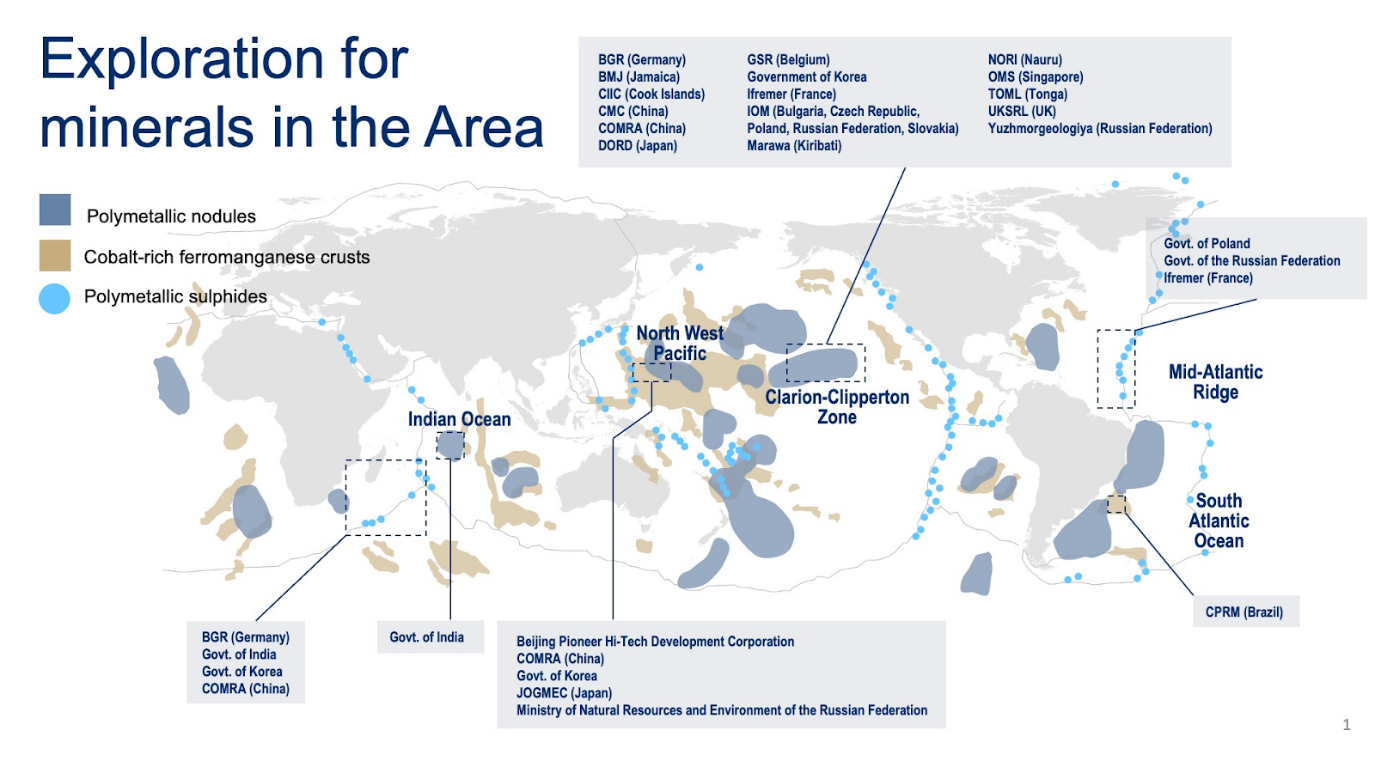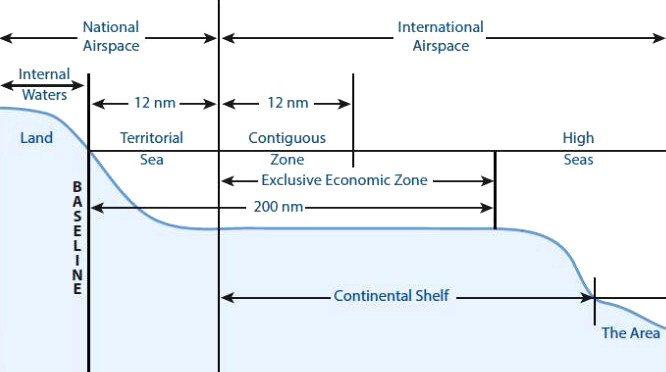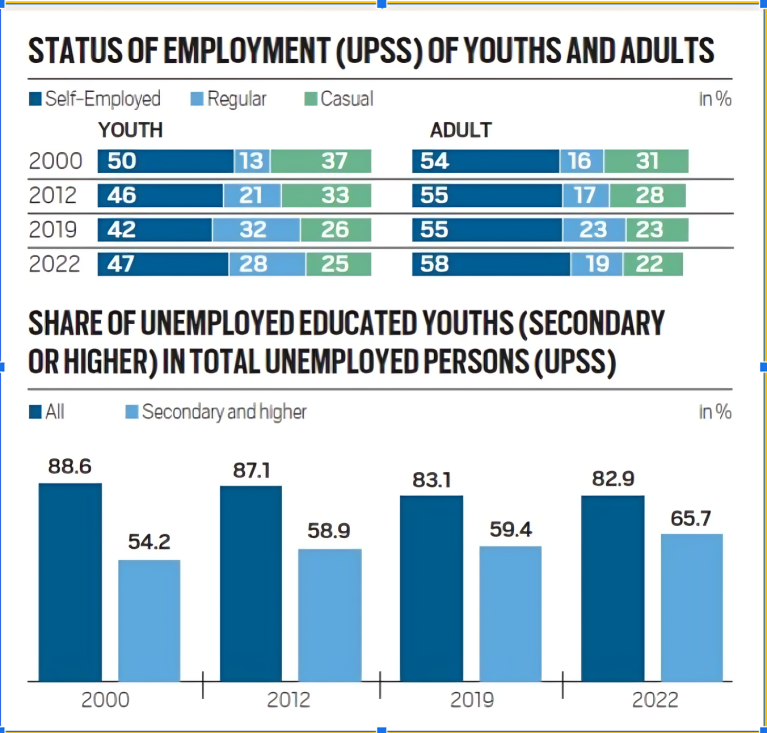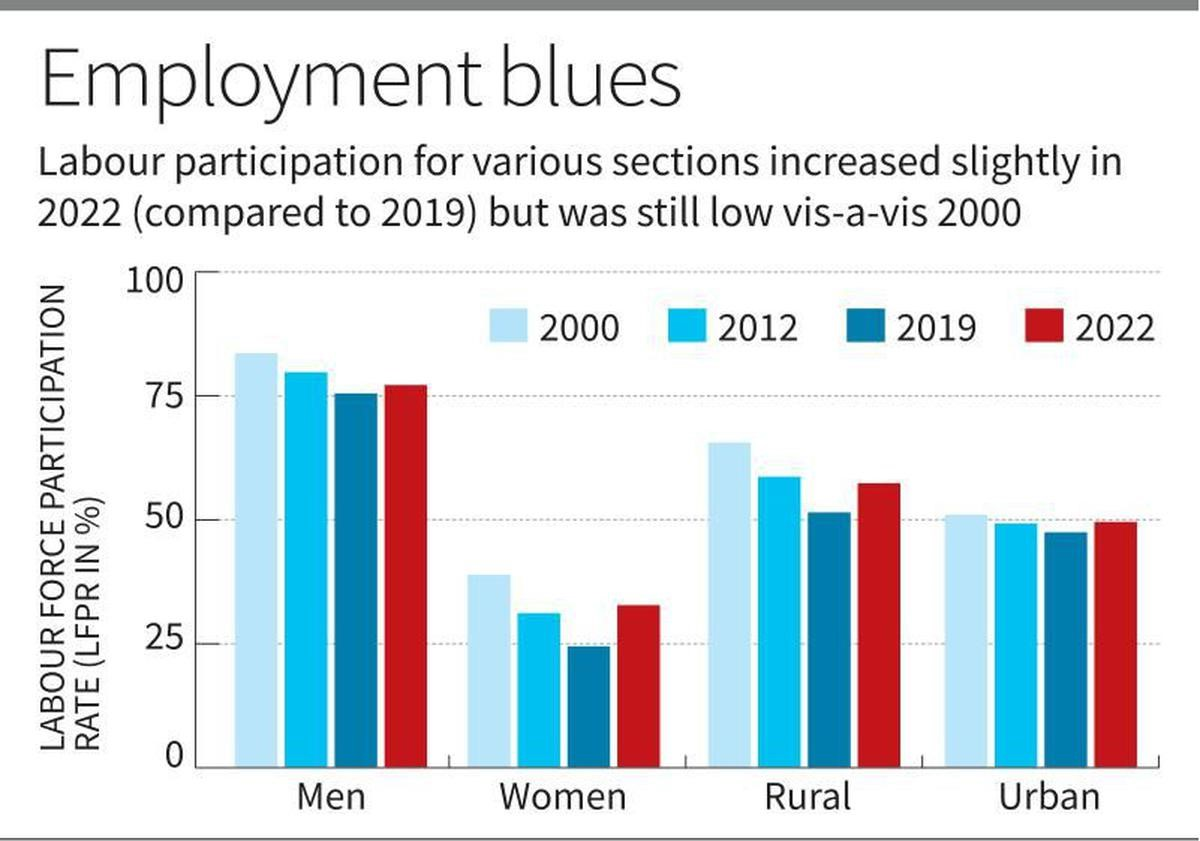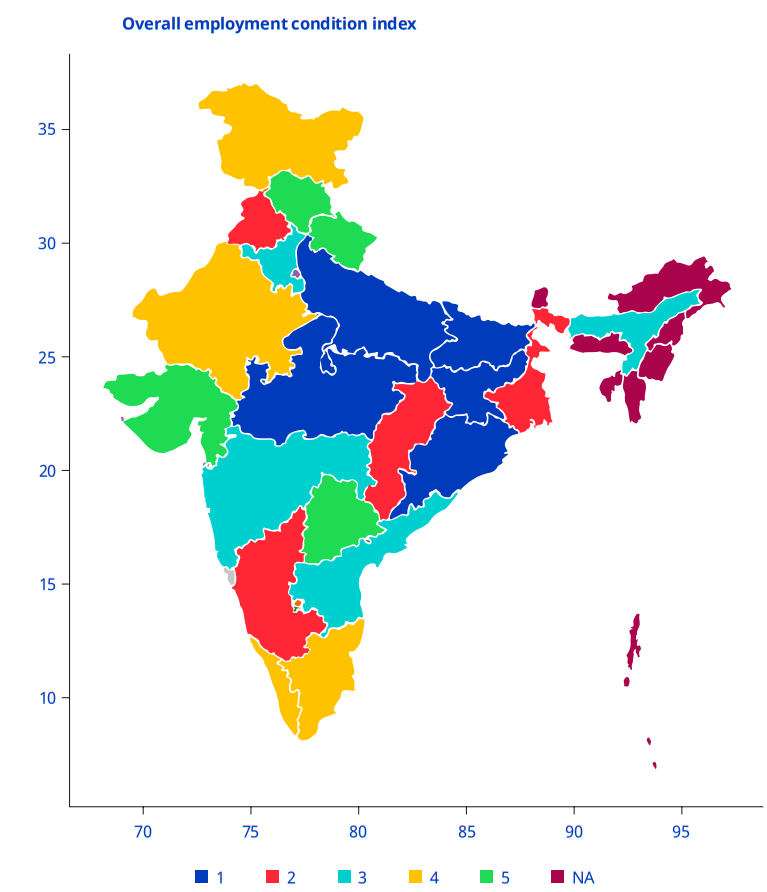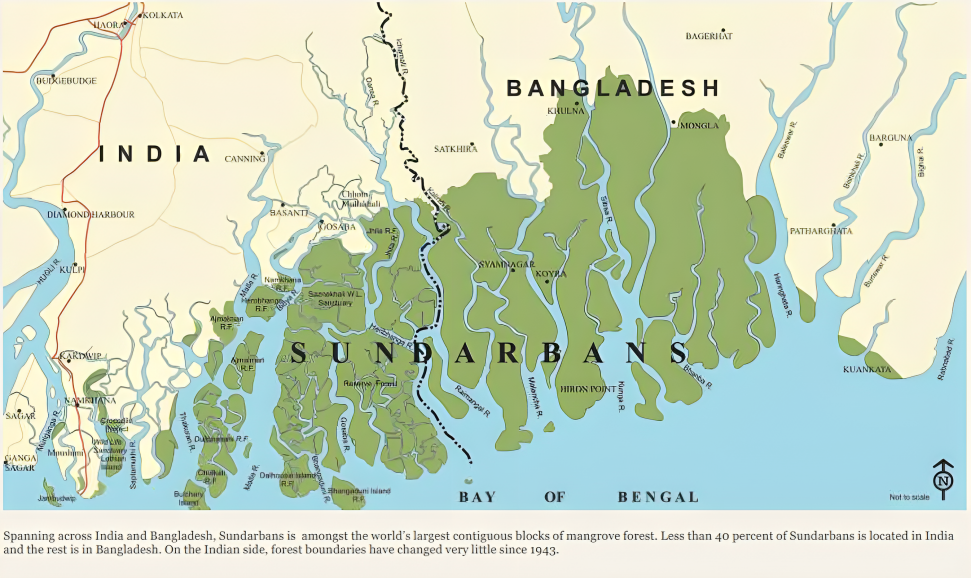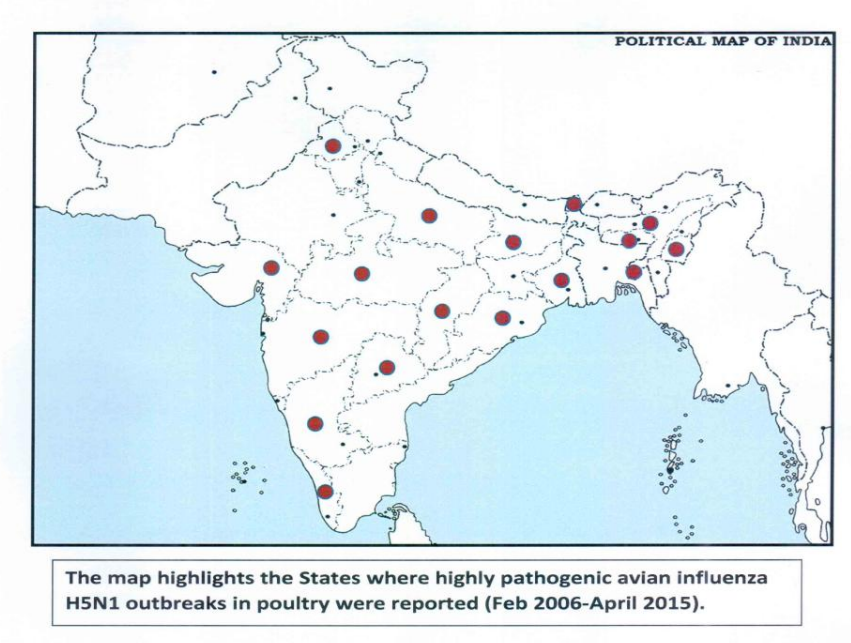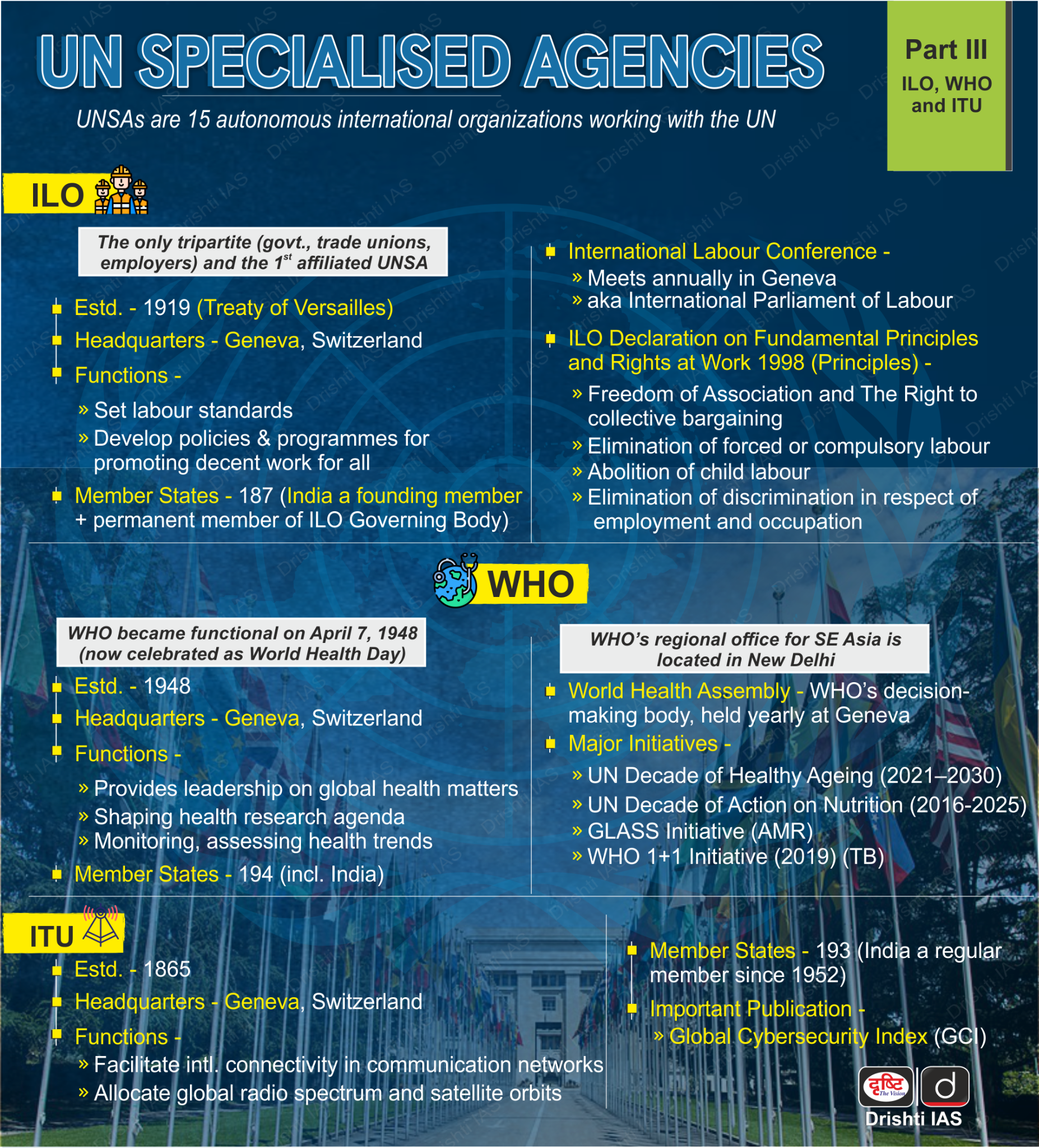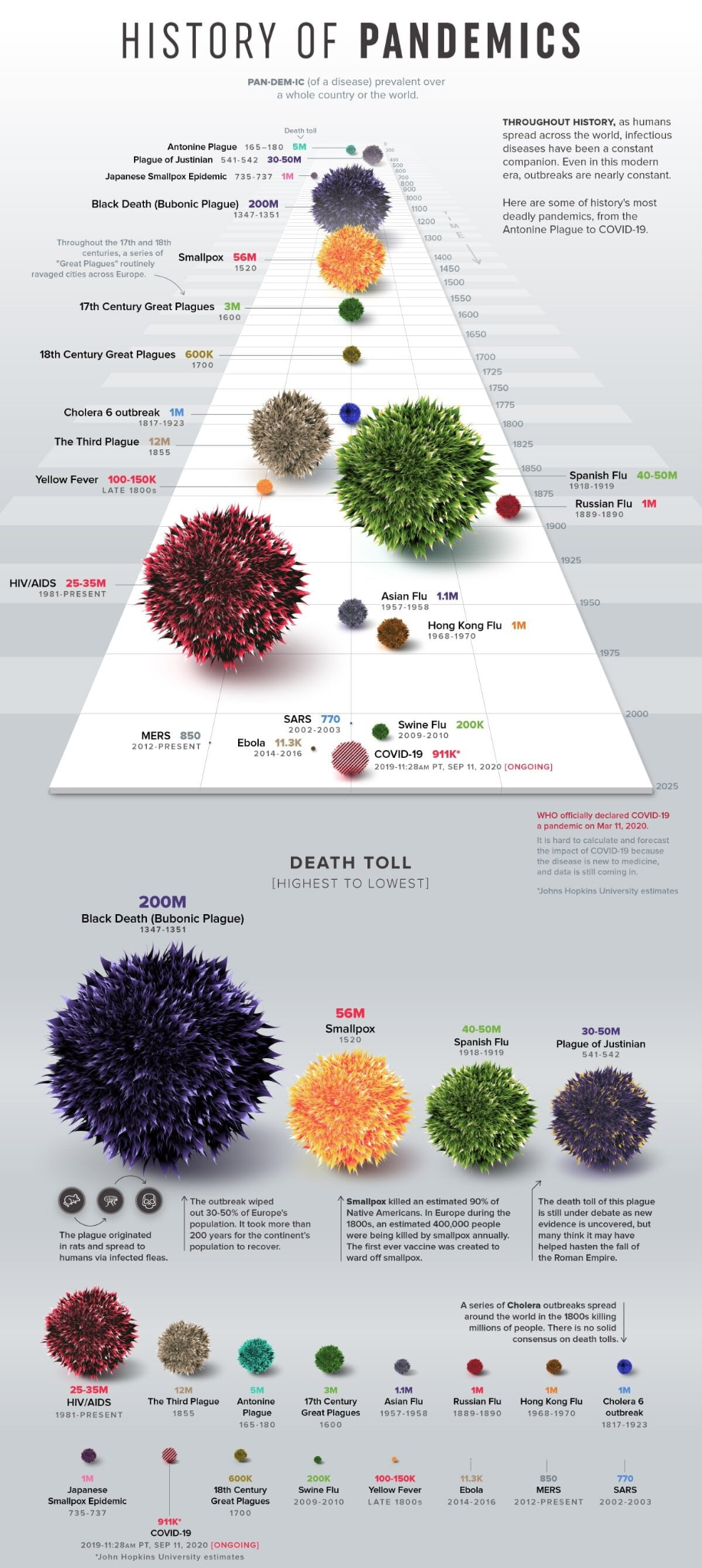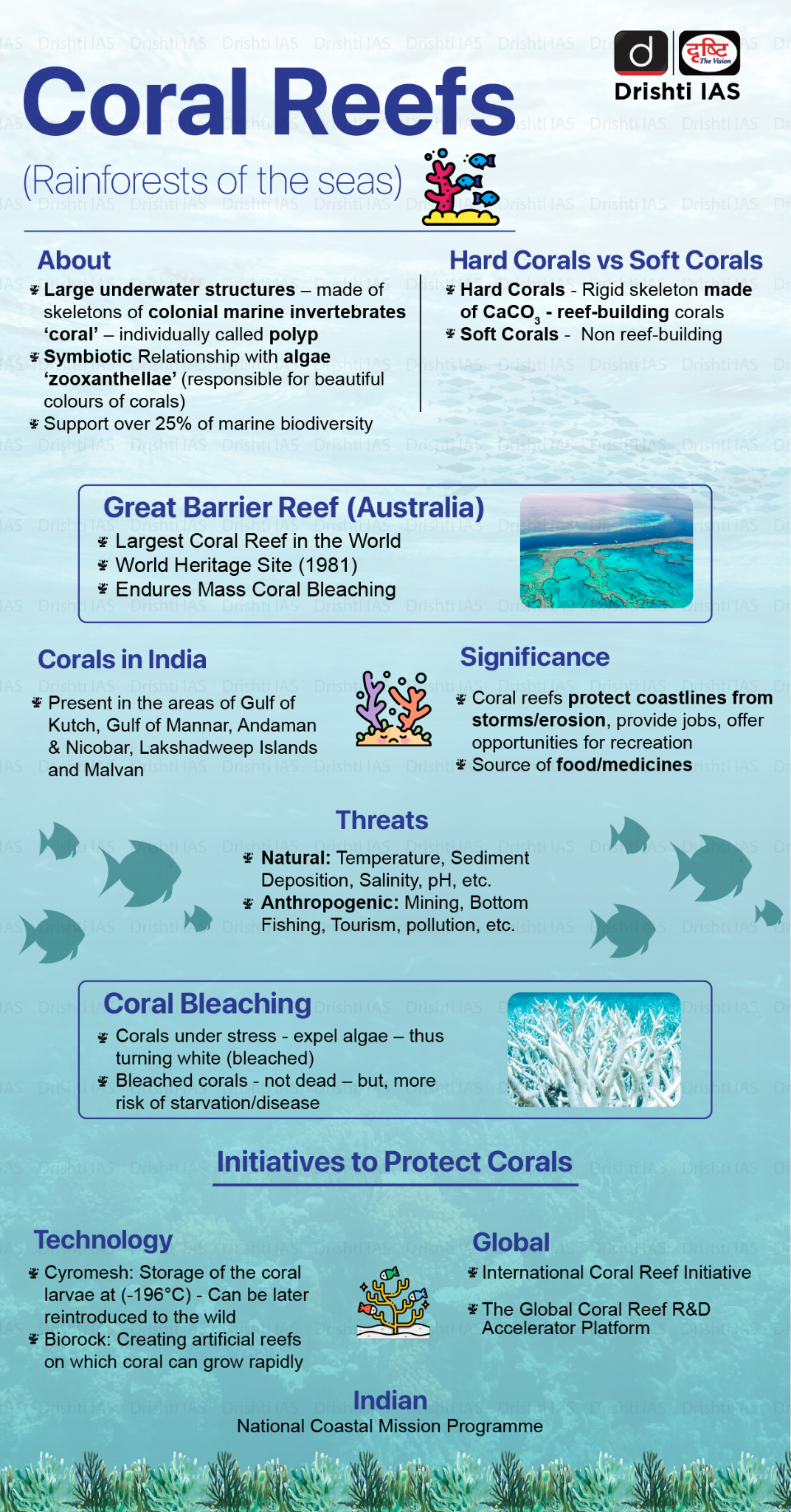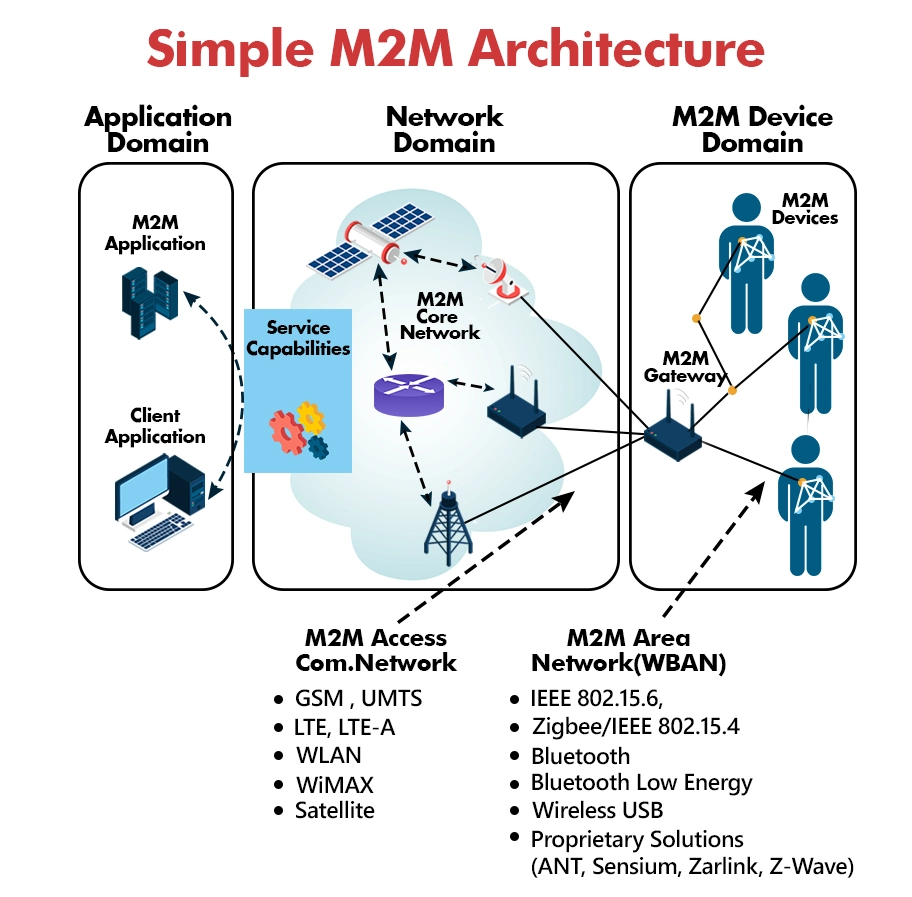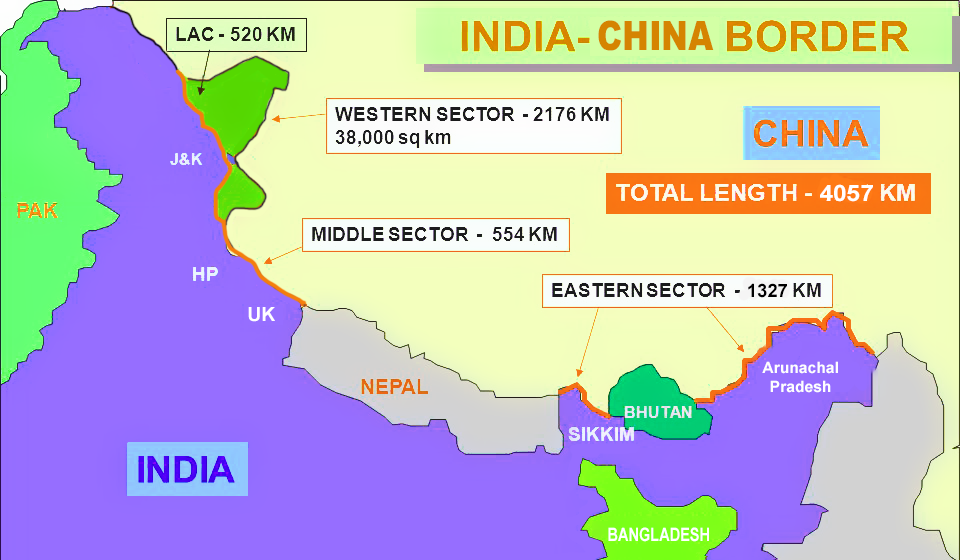Geography
India Joins Sri Lanka in Seabed Mining Race
For Prelims: Indian Ocean Seabed, Cobalt-Rich Afanasy Nikitin Seamount (AN Seamount), International Seabed Authority (ISBA), United Nations Convention on the Law of the Sea (UNCLOS), Internal Waters, Territorial Sea, Contiguous Zone, Exclusive Economic Zone (EEZ), Continental Self, Bay of Bengal
For Mains: Economic and diplomatic significance of the right to explore the Indian Ocean sea bed
Why in News?
Recently, India applied for Rights to Explore the Indian Ocean Seabed Beyond its Jurisdiction, Including Cobalt-Rich Afanasy Nikitin Seamount (AN Seamount). India's interest is fueled by concerns over Chinese vessels conducting reconnaissance there.
- Rights to the region have already been claimed by Sri Lanka under a separate set of laws.
What is Afanasy Nikitin Seamount (AN Seamount)?
- The AN Seamount is a structural feature (400 km long and 150 km wide) in the Central Indian Basin, located about 3,000 km away from India’s coast.
- From an oceanic depth of about 4,800 km, it rises to about 1,200 meters and it is rich in deposits of cobalt, nickel, manganese and copper.
- To proceed with extraction, interested parties/countries must first apply for an exploration license to the International Seabed Authority (ISBA). This organisation operates autonomously under the United Nations Convention on the Law of the Sea (UNCLOS).
- These rights are specific to areas that are part of the open ocean. Around 60% of the world’s seas are open ocean and though believed to be rich in a variety of mineral wealth, the costs and challenges of extraction are prohibitive.
Which Countries have been Provided with Exploration Licences?
- Both state-owned and government-sponsored companies from India, France, Russia, Germany, China, Singapore and the UK had sought permission for minerals prospecting in the high seas.
- Licence Granted:
- Four licences have been granted for the Pacific Ocean, the Clarion Clipperton Zone between Hawaii and Mexico and the Magellan Seamount in the northwest Pacific.
- Two licences are for the Indian Ocean Ridge, while one for Rio Grande Rise in the southern Atlantic.
- India's Exploration Applications: Along with the application for AN Seamount, India has also applied for permission to explore another region, spanning 3,00,000 square km, called the Carlsberg Ridge in the Central Indian Ocean to investigate for polymetallic sulphides, which are large smoking mounds near hydrothermal vents that are reportedly rich in copper, zinc, gold and silver.
- Previous Exploration Efforts: India has previously secured exploration rights to two other large basins in the Central Indian Ocean and has undertaken surveys in these regions, demonstrating its commitment to marine exploration and resource assessment.
- India has been studying the seabed and carrying out test mining for about two decades through institutes like National Institute of Oceanography (NIO) and National Institute of Ocean Technology (NIOT) .
What is Deep Sea Bed Mining?
- Deep-sea mining involves extracting valuable mineral deposits from the ocean floor at depths ranging from 200 to 6,500 meters below the surface.
- These mineral deposits include materials such as copper, cobalt, nickel, zinc, silver, gold, and rare earth elements.
- NIO has tested deep-sea mining systems up to 512 meters depth and is working on systems for up to 6,000 meters.
- Establishing deep-sea mines was earlier considered more expensive than land-based mining.
- Innovations in underwater robotics from the petroleum industry have improved prospects for deep-sea mining.
What are the Different Maritime Zones?
- Baseline:
- A baseline refers to a line, often along the coastline, serving as a reference point for measuring the outer boundaries of a state's territorial sea and other maritime zones, such as its exclusive economic zone.
- Typically, this baseline mirrors the low-water mark of the coastal state. In cases where the coastline is deeply indented, contains islands close to the shore, or exhibits significant instability, straight baselines may be established instead.
- Internal Waters:
- Internal waters are waters on the landward side of the baseline from which the breadth of the territorial sea is measured.
- Each coastal state has full sovereignty over its internal waters as like its land territory. Examples of internal waters include bays, ports, inlets, rivers and even lakes that are connected to the sea.
- There is no right to innocent passage through internal waters.
- The innocent passage refers to the passing through the waters which are not prejudicial to peace and security. However, the nations have the right to suspend the same.
- Territorial Sea:
- The territorial sea extends seaward up to 12 nautical miles (nm) from its baselines.
- The coastal states have sovereignty and jurisdiction over the territorial sea. These rights extend not only to the surface but also to the seabed, subsoil, and even airspace.
- However, the coastal states’ rights are limited by the innocent passage through the territorial sea.
- The territorial sea extends seaward up to 12 nautical miles (nm) from its baselines.
- Contiguous Zone:
- The contiguous zone adjacent to and beyond its territorial sea that extends seaward up to 24 nm from its baselines.
- It is an intermediary zone between the territorial sea and the high seas.
- The coastal state has the right to both prevent and punish infringement of fiscal, immigration, sanitary, and customs laws within its territory and territorial sea.
- Unlike the territorial sea, the contiguous zone only gives jurisdiction to a state on the ocean’s surface and floor. It does not provide air and space rights.
- Exclusive Economic Zone (EEZ):
- Each coastal State may claim an EEZ beyond and adjacent to its territorial sea that extends seaward up to 200 nm from its baselines.
- Within its EEZ, a coastal state has:
- Sovereign rights to explore, exploit, conserve and manage natural resources, whether living or nonliving, of the seabed and subsoil.
- Rights to carry out activities like the production of energy from the water, currents and wind.
- Unlike the territorial sea and the contiguous zone, the EEZ only allows for the above-mentioned resource rights. It does not give a coastal state the right to prohibit or limit freedom of navigation or overflight, subject to very limited exceptions.
- Continental Self:
- A continental shelf is the edge of a continent that lies under the ocean. A continental shelf extends from the coastline of a continent to a drop-off point called the shelf break.
- From the break, the shelf descends toward the deep ocean floor in what is called the continental slope.
- A continental shelf is the edge of a continent that lies under the ocean. A continental shelf extends from the coastline of a continent to a drop-off point called the shelf break.
- High Seas:
- The ocean surface and the water column beyond the EEZ are referred to as the high seas.
- It is considered as “the common heritage of all mankind” and is beyond any national jurisdiction.
- States can conduct activities in these areas as long as they are for peaceful purposes, such as transit, marine science, and undersea exploration.
What are the Continental Shelf Claims and Exploration Rights?
- Exclusive Rights to Continental Shelf: Countries possess exclusive rights up to 200 nautical miles from their borders, including the underlying seabed. This jurisdiction extends to the exploration and potential exploitation of resources within this zone.
- Continental Shelf Extension: Some ocean-bound states may have a natural land formation connecting their border to the edge of the deep ocean, extending beyond the 200-nautical-mile limit. This extension is known as the continental shelf.
- Special Provisions: There is a provision allowing countries along the Bay of Bengal to apply a different set of criteria for making claims on the extent of their continental shelf.
- Example: Utilising a special provision, Sri Lanka has asserted a claim for an extension of its continental shelf up to 500 nautical miles, exceeding the usual limit of 350 nautical miles.
- Rational Support to Claim: To claim exclusive rights to the continental shelf beyond 200 nautical miles, a country must provide a detailed scientific rationale supported by underwater maps and surveys. This information is submitted to a scientific commission appointed by the International Seabed Authority (ISBA).
- If the claim is approved by the commission, the country gains primacy to explore and potentially exploit both living and non-living resources within the extended continental shelf.
What is the Significance of Deep Sea Mining?
- Resource Accessibility: Deep sea mining provides access to valuable resources that are becoming increasingly scarce on land. These resources include polymetallic nodules, polymetallic sulphides, and cobalt-rich ferromanganese crusts, which contain high concentrations of minerals such as copper, nickel, cobalt, and rare earth elements.
- As terrestrial deposits become depleted, deep-sea mining offers an alternative source of these critical materials.
- Technological Advancements: Developing technologies for deep-sea mining presents opportunities for innovation and technological advancement. This includes the design of specialised equipment capable of operating in extreme oceanic conditions, such as high pressure, darkness, and low temperatures.
- Advancements in robotics, remotely operated vehicles (ROVs), and autonomous underwater vehicles (AUVs) are essential for efficient and safe mining operations.
- Economic Potential: Deep sea mining has the potential to generate significant economic benefits for participating countries and companies.
- The extraction of valuable minerals from the ocean floor can stimulate economic growth, create employment opportunities, and contribute to national revenue through taxes, royalties, and resource-sharing agreements.
What are the Concerns Related to Deep Sea Mining?
- Damage to Marine Ecosystem: Deep Sea Mining can damage the Marine Ecosystem and ecosystems. Damage from mining can include noise, vibration and light pollution, as well as possible leaks and spills of fuels and other chemicals used in the mining process.
- It could severely harm marine biodiversity and ecosystems,
- Sediment Plumes Formation: It will stir up fine sediments on the seafloor, creating plumes of suspended particles. Once valuable materials are extracted, slurry sediment plumes are sometimes pumped back into the sea.
- That can harm filter-feeding species like corals and sponges and could smother or otherwise interfere with some creatures.
- Wider Impact on Marine Population: Deep-sea mining would go beyond harming the seabed and have a wider impact on fish populations, marine mammals and the essential function of the deep-sea ecosystems in regulating the climate.
- Digging & Gauging: The digging and gauging of the ocean floor by machines can alter or destroy deep-sea habitats and can harm yet unknown species of greater depth at sea.
United Nations Convention on the Law of the Sea 1982
- About:
- The UNCLOS is an international treaty that provides a regulatory framework for the use of the world’s seas and oceans.
- It lays down a comprehensive regime of law and order in the world's oceans and seas establishing rules governing all uses of the oceans and their resources.
- It enshrines the notion that all problems of ocean space are closely interrelated and need to be addressed as a whole.
- Ratification:
- The Convention was opened for signature in December 1982 in Montego Bay, Jamaica.
- The convention has been ratified by 168 parties, which includes 167 states (164 United Nations (UN) member states plus the UN Observer state Palestine, as well as the Cook Islands and Niue) and the European Union. An additional 14 UN member states have signed, but not ratified the convention.
- While India ratified UN Law of the Seas in 1995, the US has failed to do it so far.
- Indian Law:
- As per India’s Territorial Waters, Continental Shelf, Exclusive Economic Zone and Other Maritime Zones Act, 1976:
- All foreign ships (other than warships including submarines and other underwater vehicles) shall enjoy the right of innocent passage through the territorial waters.
- Innocent passage: It is the passage that is not prejudicial to the peace, good order or security of India.
- All foreign ships (other than warships including submarines and other underwater vehicles) shall enjoy the right of innocent passage through the territorial waters.
- As per India’s Territorial Waters, Continental Shelf, Exclusive Economic Zone and Other Maritime Zones Act, 1976:
What are other Blue Economy Initiatives?
- India-Norway Task Force on Blue Economy for Sustainable Development:
- Sagarmala project
- O-SMART
- Integrated Coastal Zone Management
- National Fisheries policy
Way Forward
- Regulatory Framework Enhancement: Strengthening regulations and international agreements to ensure responsible and sustainable deep-sea mining practices are essential. This includes setting stringent guidelines for noise, vibration, and light pollution, as well as strict protocols for the handling and disposal of mining by-products and chemicals.
- Environmental Impact Assessments: Conducting thorough environmental impact assessments before granting mining licenses is crucial. These assessments should evaluate potential damage to marine ecosystems, biodiversity, and habitats, as well as the long-term effects on fish populations and marine mammals.
- Mitigation Measures: Implementing effective mitigation measures to minimize the impact of deep-sea mining activities is vital. This could involve using advanced technologies to reduce noise and light pollution, employing sediment control measures to prevent the spread of suspended particles, and developing innovative methods for waste management and disposal.
- Monitoring and Enforcement: Establishing robust monitoring mechanisms to track the environmental impact of deep-sea mining operations is necessary. Regular inspections and enforcement of regulations can ensure compliance with environmental standards and prompt intervention in case of any violations.
Read more: Deep Sea Mining, Deep Sea Mining and its Threats, India’s Deep Ocean Mission
UPSC Civil Services Examination Previous Year Question (PYQ) nation
Prelims
Q1. With reference to ‘Indian Ocean Rim Association for Regional Cooperation (IOR-ARC)’, consider the following statements: (2015)
- It was established very recently in response to incidents of piracy and accidents of oil spills.
- It is an alliance meant for maritime security only.
Which of the statements given above is/ are correct?
(a) 1 only
(b) 2 only
(c) Both 1 and 2
(d) Neither 1 nor 2
Ans: (d)
Exp:
- Indian Ocean Rim Association for Regional Cooperation (IOR-ARC) is a regional cooperation initiative of the Indian Ocean Rim countries which was established in Mauritius in March 1997 with the aim of promoting economic and technical cooperation among its members. Hence, statement 1 is not correct.
- IOR-ARC is the only pan-Indian ocean grouping. It has 23 Member States and 9 Dialogue Partners.
- It aims to create a platform for trade, and socio-economic and cultural cooperation in the Indian Ocean Rim area, which constitutes a population of about two billion people. Hence, statement 2 is not correct.
- The Indian Ocean Rim is rich in strategic and precious minerals, metals and other natural resources, marine resources, and energy, all of which can be sourced from Exclusive Economic Zones (EEZ), continental shelves, and the deep seabed. Therefore, option (d) is the correct answer.
Q2. Consider the following statements: (2021)
- The Global Ocean Commission grants licences for seabed exploration and mining in international waters.
- India has received licences for seabed mineral exploration in international waters
- ‘Rare earth minerals’ are present on the seafloor in international waters.
Which of the statements given above are correct?
(a) 1 and 2 only
(b) 2 and 3 only
(c) 1 and 3 only
(d) 1, 2 and 3
Ans: (b)
Mains
Q. Critically evaluate the various resources of the oceans which can be harnessed to meet the resource crisis in the world. (2014)


Governance
Black Carbon Emissions and PMUY
For Prelims: Black Carbon, Carbon Neutrality, Renewable Energy, Biomass, Climate Change, Air Pollution, Global Warming, Fossil Fuel, Air Pollutant, Pradhan Mantri Ujjwala Yojana (PMUY), Liquefied Petroleum Gas (LPG), Ujjwala 2.0, BS-VI norms, Ethanol Blending, Sustainable Alternative Towards Affordable Transportation (SATAT), Compressed Bio-Gas (CBG), National Clean Air Programme, FAME Scheme.
For Mains: Contribution of Pradhan Mantri Ujjwala Yojana (PMUY) in India's effort to achieve net zero emission.
Why in News?
During the UNFCCC COP26 climate talks in Glasgow in November 2021, India committed to attaining net-zero emissions by 2070, positioning itself as a leading contender in the pursuit of carbon neutrality.
- As per the Ministry of New and Renewable Energy, India has established a renewable energy capacity surpassing 180 GW by 2023 and is on track to achieve its goal of reaching 500 GW by 2030.
- Pradhan Mantri Ujjwala Yojana (PMUY), a scheme of the government of India can contribute to net zero emission significantly by mitigating the black carbon emission.
What is Black Carbon (BC)?
- About:
- Black carbon (BC) is the dark, sooty material emitted alongside other pollutants when biomass and fossil fuels are not fully combusted.
- BC is a short-lived pollutant that is the second-largest contributor to warming the planet behind carbon dioxide (CO2).
- Unlike other greenhouse gas emissions, BC is quickly washed out and can be eliminated from the atmosphere if emissions stop.
- Unlike historical carbon emissions it is also a localised source with greater local impact.
- Black carbon is a kind of an aerosol.
- Impacts:
- Among aerosols (such as brown carbon, sulphates), Black Carbon has been recognized as the second most important anthropogenic agent for climate change and the primary marker to understand the adverse effects caused by air pollution.
- Black carbon absorbs solar energy, it warms the atmosphere. When it falls to earth with precipitation, it darkens the surface of snow and ice, reducing their albedo (the reflecting power of a surface), warming the snow, and hastening melting.
- It contributes to global warming and poses severe risks. Studies have found a direct link between exposure to black carbon and a higher risk of heart disease, birth complications, and premature death.
- Among aerosols (such as brown carbon, sulphates), Black Carbon has been recognized as the second most important anthropogenic agent for climate change and the primary marker to understand the adverse effects caused by air pollution.
- Source:
- Most black carbon emissions in India arise from burning biomass, such as cow dung or straw, in traditional cookstoves.
- It gets emitted from gas and diesel engines, coal-fired power plants, and other sources that burn fossil fuel. It comprises a significant portion of particulate matter (PM).
- According to a 2016 study, the residential sector contributes 47% of India’s total black carbon emissions.
- Industries contribute a further 22%, diesel vehicles 17%, open burning 12%, and other sources 2%.
What is Pradhan Mantri Ujjwala Yojana (PMUY)?
- About:
- The Ministry of Petroleum and Natural Gas (MoPNG), introduced the ‘Pradhan Mantri Ujjwala Yojana’ (PMUY) in 2016 as a flagship scheme with the objective of making clean cooking fuel such as LPG available to the rural and deprived households which were otherwise using traditional cooking fuels such as firewood, coal, cow-dung cakes etc.
- Usage of traditional cooking fuels had detrimental impacts on the health of rural women as well as on the environment due to huge emission of particulate matter and black carbon.
- The Ministry of Petroleum and Natural Gas (MoPNG), introduced the ‘Pradhan Mantri Ujjwala Yojana’ (PMUY) in 2016 as a flagship scheme with the objective of making clean cooking fuel such as LPG available to the rural and deprived households which were otherwise using traditional cooking fuels such as firewood, coal, cow-dung cakes etc.
- Objectives:
- Reducing the number of deaths in India due to unclean cooking fuel which emits more black carbon.
- Preventing young children from a significant number of acute respiratory illnesses caused due to indoor air pollution by burning fossil fuel and black carbon emission.
- To make clean cooking fuel available to rural and poor households and reduce their dependence on traditional cooking fuels.
- To set up infrastructure to accompany LPG connections, which includes providing complimentary gas stoves, deposits for LPG cylinders, and establishing a distribution network.
- Features:
- The scheme provides a financial support of Rs 1600 for each LPG connection to the BPL households.
- Along with a deposit-free LPG connection, Ujjwala 2.0 provides the first refill and a hotplate free of cost to the beneficiaries.
- Challenges of the Scheme in BC Emission Mitigation:
- Energy Needs and Traditional Fuels: Up to half of the energy needs of households benefiting from the PMUY are still met by traditional fuels, emitting high levels of black carbon.
- In 2022-23, 25% of all PMUY beneficiaries availed either zero LPG refill or only one LPG refill, according to RTI data, meaning they still relied entirely on traditional biomass for cooking which aggravates the emission of black carbon.
- Impact on Health and Well-being: A shortage of LPG and increased reliance on traditional fuels disproportionately affects women and children, leading to elevated indoor air pollution due to black carbon and other pollutants, health concerns, and premature deaths.
- LPG Subsidy and Affordability: In October 2023, the government increased the LPG subsidy to ₹300 from ₹200. However, despite this adjustment, the cost of a 14.2-kg LPG cylinder remains around ₹600, posing affordability challenges for many PMUY beneficiaries compared to free alternatives like cow dung and firewood.
- Cow dung and firewood are more affordable to PMUY beneficiaries so its use is more prevalent, intensifying the problem of black carbon.
- Last-Mile Connectivity Hindrance: The lack of last-mile connectivity in the LPG distribution network poses a significant challenge to the success of PMUY in reducing the black carbon emission, especially impacting remote rural areas heavily reliant on biomass burning which is a significant source of black carbon.
- Energy Needs and Traditional Fuels: Up to half of the energy needs of households benefiting from the PMUY are still met by traditional fuels, emitting high levels of black carbon.
Other Measures Taken to Mitigate Black Carbon Emission
- Introducing Cleaner Fuels: Introduction of cleaner / alternate fuels like gaseous fuel (CNG, LPG etc.), ethanol blending.
- SATAT Scheme: A new initiative Sustainable Alternative Towards Affordable Transportation (SATAT), has been launched to set up 5000 Compressed Bio-Gas (CBG) production plants and make CBG available in the market for use.
- Managing Crop Residue: Agricultural machines and equipment for in-situ crop residue management in Punjab, Haryana, Uttar Pradesh and NCT of Delhi are promoted under the Central Sector Scheme on Promoting Agricultural Mechanization for in-situ Crop Residue Management with 50% subsidy to individual farmers and 80% subsidy to the establishment of Custom Hiring Centers.
- National Clean Air Programme: Under the National Clean Air Programme, the government has set a new target: a 40% reduction in particulate matter concentration in covered cities by 2026, surpassing the previous goal of 20 to 30% reduction by 2024.
- City specific Clean Air Action Plans: The CPCB has identified 131 cities based on ambient air quality levels exceeding national ambient air quality standards, and cities with a million plus population.
- These plans define time bound targets to control city specific air polluting sources (soil & road dust, vehicles, domestic fuel, municipal solid waste burning, construction material and industries, etc.).
- FAME Scheme: Faster Adoption and Manufacturing of Electric Vehicles (FAME) phase-2 scheme has been rolled out.
Way Forward
- Coal-Bed Methane: One potential solution to this issue is the local production of coal-bed methane (CBM) gas by composting biomass. CBM is a much cleaner fuel with lower black-carbon emissions and investment.
- Panchayats can take the initiative to produce CBM gas locally at the village level, ensuring every rural household can access clean cooking fuel.
- Promoting LPG Adoption: Increase awareness campaigns to promote the benefits of LPG over traditional fuels, emphasising its positive impact on health and the environment.
- Improving Supply Chain Efficiency: Invest in infrastructure development to enhance last-mile connectivity in the LPG distribution network, ensuring reliable access to clean cooking fuel, particularly in remote rural areas.
- Diversifying Clean Energy Sources: Explore alternative clean energy sources such as biogas or solar energy for cooking purposes, particularly in areas where LPG accessibility is limited.
- Community Engagement: Engage local communities, especially women and youth, in decision-making processes related to clean energy adoption, ensuring their needs and preferences are adequately addressed.
UPSC Civil Services Examination, Previous Year Questions (PYQ)
Prelims
Q. According to India’s National Policy on Biofuels, which of the following can be used as raw materials for the production of biofuels? (2020)
- Cassava
- Damaged wheat grains
- Groundnut seeds
- Horse gram
- Rotten potatoes
- Sugar beet
Select the correct answer using the code given below:
(a) 1, 2, 5 and 6 only
(b) 1, 3, 4 and 6 only
(c) 2, 3, 4 and 5 only
(d) 1, 2, 3, 4, 5 and 6
Ans: (a)
Mains
Q. Access to affordable, reliable, sustainable and modern energy is the sine qua non to achieve Sustainable Development Goals (SDGs).” Comment on the progress made in India in this regard. (2018)


Indian Economy
India Employment Report 2024: ILO
For Prelims: India Employment Report 2024: ILO, Unemployment rates, Institute for Human Development (IHD), International Labour Organisation (ILO), Labour Force Participation Rate (LFPR), Worker Population Ratio (WPR), Unemployment Rate (UR).
For Mains: India Employment Report 2024: ILO, Major Issues Related to Unemployment in India.
Why in News?
Recently, the Institute for Human Development (IHD) and International Labour Organisation (ILO) have released a report titled- ‘India Employment Report 2024’, which highlights that India’s youth continue to grapple with soaring Unemployment rates.
- The Institute for Human Development (IHD) was established in the year 1998 under the aegis of the Indian Society of Labour Economics (ISLE), it is a non-profit autonomous institution that aims to contribute towards building a society that fosters and values an inclusive social, economic and political system that is free from poverty and deprivations.
Note
The India Employment Report 2024 is the third in the series of regular publications by the IHD on labour and employment issues. This report on Youth Employment, Education and Skills examines the challenge of youth employment in the context of the emerging economic, labour market, educational and skills scenario in India and changes over the past two decades.
- The report is primarily based on analysis of data from the National Sample Surveys and the Periodic Labour Force Surveys between 2000 and 2022, with a postscript for 2023.
What are the Key Highlights of the Report?
- Poor Employment Conditions:
- Despite improvements in overall labour force participation and employment rates, employment conditions in India remain poor, with issues such as stagnant or declining wages, increased self-employment among women, and a higher proportion of unpaid family work among youth.
- India’s youth account for almost 83% of the unemployed workforce and the share of youngsters with secondary or higher education in the total unemployed has almost doubled from 35.2% in 2000 to 65.7% in 2022.
- Youth Employment Challenges:
- Youth employment and underemployment surged between 2000 and 2019, with educated youths experiencing significantly higher levels of joblessness.
- The Labour Force Participation Rate (LFPR), Worker Population Ratio (WPR) and the Unemployment Rate (UR) showed a long-term deterioration between 2000 and 2018 but witnessed an improvement after 2019.
- The improvement coincides with periods of economic distress, both pre and post-Covid-19 with the exception of two peak Covid-19 quarters.
- Paradoxical Improvements:
- Over the past two decades, India's job market has seen some improvements in certain labour indicators, but the overall employment situation remains challenging.
- Non-farm sectors have not grown sufficiently to absorb workers from agriculture, despite non-farm employment growing faster than farm employment before 2018.
- Most workers, around 90%, are engaged in informal work, and the proportion of regular employment, which was steadily increasing after 2000, started declining after 2018.
- India's large young workforce, often seen as a demographic advantage, faces challenges due to a lack of necessary skills.
- A significant portion of youth lacks basic digital literacy skills, with 75% unable to send emails with attachments, 60% unable to copy and paste files, and 90% unable to perform basic spreadsheet tasks like putting a mathematical formula.
- Wages and Earnings are Declining:
- While wages of casual labourers maintained a modest upward trend during 2012–22, real wages of regular workers either remained stagnant or declined. Self Employed real earnings also declined after 2019.
- Overall, wages have remained low. As much as 62% of the unskilled casual agricultural workers and 70% of such workers in the construction sector at the all-India level did not receive the prescribed daily minimum wages in 2022.
- Changing the Structure of Industrial Employment:
- There has been a rapid introduction of digitally mediated gig and platform work, which are algorithmically controlled by the platforms and have brought about new features in control of the labour process.
- Increasingly, platform and gig work have been expanding, but it is, to a large extent, the extension of informal work, with hardly any social security provisions.
- Migration is Likely to Increase in Future:
- The rates of urbanization and migration are expected to considerably increase in the future.
- India is expected to have a migration rate of around 40% in 2030 and will have an urban population of around 607 million.
- The bulk of this increase in urban growth will come from migration. The pattern of migration also shows regional imbalance in the labour markets.
- The direction of migration in general is from eastern, north-eastern and central regions to southern, western and northern regions.
- Regional Disparities:
- Significant variations in employment outcomes exist across states, with certain states consistently ranking lower in employment indicators.
- States like Bihar, Uttar Pradesh, Odisha, Madhya Pradesh, Jharkhand, and Chhattisgarh have struggled with poor employment outcomes over the years, reflecting the influence of regional policies.
- Widening Gender Gap:
- India is facing the challenge of a substantial gender gap in the labour market, with low rates of female labour force participation.
- The unemployment challenge among young women, especially those who are highly educated, is enormous.
- Social inequalities also persist despite affirmative action and targeted policies, with Scheduled Castes and Scheduled Tribes facing barriers to accessing better job opportunities.
- Although educational attainment has improved across all groups, social hierarchies persist, exacerbating the employment disparity.
- Policy Recommendations:
- To enhance production and foster growth with a focus on employment, policy recommendations are proposed:
- Integrate an employment creation agenda into macroeconomic policies, particularly emphasising productive non-farm employment, notably in manufacturing.
- Prioritise labour-intensive manufacturing to absorb unskilled labour and complement with selected services.
- Concentrate efforts on supporting micro, small, and medium-sized enterprises through a decentralised approach.
- Increase agricultural productivity, generate non-farm employment opportunities, and encourage entrepreneurship.
- Invest in green and blue economies, leveraging strategic investments, capacity-building initiatives, and policy frameworks to unlock substantial employment potential.
- To enhance job quality, strategies are recommended:
- There's a need to invest in and regulate sectors such as the care industry and the digital economy, which are anticipated to be significant sources of employment for young people.
- Fostering an inclusive urbanisation and migration policy is essential, particularly given India's projected rise in urbanisation and migration rates, driven by youths seeking decent employment opportunities, predominantly in urban areas.
- Ensuring a robust supportive role for labour policy and regulation is crucial. This involves guaranteeing a minimum standard of employment quality and safeguarding basic rights for workers across all sectors.
- To address labour market inequalities, key approaches are suggested:
- Implement policies to enhance women's participation in quality employment.
- Integrate high-quality skills training into education to uplift economically disadvantaged groups and boost employability.
- Iimprove access to information technology and bridge the digital gap. Establish a fair labour market by combating discrimination against women and marginalised communities.
- To enhance production and foster growth with a focus on employment, policy recommendations are proposed:
What are the Government’s Initiatives Related to Employment?
- Support for Marginalised Individuals for Livelihood and Enterprise (SMILE)
- PM-DAKSH (Pradhan Mantri Dakshta Aur Kushalta Sampann Hitgrahi)
- Mahatma Gandhi National Rural Employment Guarantee Act (MGNREGA)
- Pradhan Mantri Kaushal Vikas Yojana (PMKVY)
- Start Up India Scheme
- Rozgar Mela
- Indira Gandhi Urban Employment Guarantee Scheme- Rajasthan.
What is the International Labor Organization?
- It is the only tripartite United Nations (UN) agency. It brings together governments, employers and workers of 187 Member States (India is a member), to set labour standards, develop policies and devise programmes promoting decent work for all women and men.
- It received the Nobel Peace Prize in 1969.
- It was established in 1919 by the Treaty of Versailles as an affiliated agency of the League of Nations and became the first affiliated specialised agency of the UN in 1946.
- Headquarters: Geneva, Switzerland
Read more: NFHS-5 National Report, Household Consumption Expenditure Survey 2022-23
UPSC Civil Services Examination, Previous Year Questions (PYQs)
Prelims
Q. Disguised unemployment generally means (2013)
(a) large number of people remain unemployed
(b) alternative employment is not available
(c) marginal productivity of labour is zero
(d) productivity of workers is low
Ans: (c)
Mains
Q. Most of the unemployment in India is structural in nature. Examine the methodology adopted to compute unemployment in the country and suggest improvements. (2023)
Biodiversity & Environment
Sundarbans
For Prelims: Sundarbans, Estuarine crocodile, water monitor lizard, Gangetic dolphin, Olive ridley turtle. Bay of Bengal.
For Mains: Sundarbans, Challenges Related to Sundarban, Nature-based Solutions.
Why in News?
The Sundarbans face numerous environmental challenges including freshwater scarcity, pollution from microplastics and chemicals, and coastal erosion, making it important to look for sustainable solutions to protect it.
What is Sundarbans?
- About:
- The Sundarbans hosts the largest mangrove forests in the world, lying on the delta of the Ganges, Brahmaputra and Meghna rivers on the Bay of Bengal.
- The mangrove ecosystem is a specialised environment between the land and the sea in the tropical and subtropical regions.
- The Sundarbans hosts the largest mangrove forests in the world, lying on the delta of the Ganges, Brahmaputra and Meghna rivers on the Bay of Bengal.
- Flora Fauna:
- It provides shelter for 84 species of flora, including 26 mangrove species, 453 species of fauna, 120 species of fish, 290 species of birds, 42 species of mammals, 35 reptiles and eight amphibian species. More than 12 million people — 4.5 million in India and 7.5 million in Bangladesh — live in this estuarine ecosystem.
- Sundarban is the natural abode of many animal groups and many species are known to feed, breed and take shelter in this ecosystem.
- It is home to many rare and globally threatened wildlife species such as the estuarine crocodile, water monitor lizard, Gangetic dolphin and olive ridley turtle.
- Protection:
- 40% of Sundarban lies in India and the rest in Bangladesh. Sundarban was designated a UNESCO World Heritage site in 1987 (India) and 1997 (Bangladesh).
- Sundarban Wetland, India was recognised as the ‘Wetland of International Importance’ under the Ramsar Convention in January 2019.
- Project TIger: Project Tiger is one of the most important steps in conserving the Sundarbans unique ecosystem because it protected the entire forest by preserving the Royal Bengal Tiger population.
- MOU between India and Bangladesh on Conservation of the Sundarban: In 2011 Both India and Bangladesh signed an MoU on Conservation of the Sundarbans, recognising the need to monitor and conserve the Sundarbans.
- Biosphere Reserve:
- Sundarbans is also a Biosphere Reserve (BR), Within which there are several protected areas, including national parks and wildlife sanctuaries, they are,
- Sundarbans National Park (India)
- Sundarbans East Wildlife Sanctuary (India)
- Sundarbans South Wildlife Sanctuary (India)
- Sundarbans West Wildlife Sanctuary (India)
- Sundarbans Reserve Forest (Bangladesh)
- Sundarbans is also a Biosphere Reserve (BR), Within which there are several protected areas, including national parks and wildlife sanctuaries, they are,
What are the Challenges Faced by the Sundarbans?
- Freshwater Scarcity:
- The Sundarbans experience scarcity of freshwater due to the predominantly saline nature of the rivers, impacting both the ecosystem and the livelihoods of inhabitants.
- According to the observations of the experts, fresh groundwater may be found deeper than 250 metres and, in some cases, the groundwater is saline in nature in Sundarbans.
- The Sundarbans experience scarcity of freshwater due to the predominantly saline nature of the rivers, impacting both the ecosystem and the livelihoods of inhabitants.
- Pollution and Erosion:
- Pollution from various sources, including microplastics, chemicals from industrial activities, and waste disposal, threatens the delicate ecosystem of the Sundarbans and the health of its inhabitants.
- In some of the study reports, it was found four million tonnes of microplastics are released into the Bay of Bengal and the Sundarbans each year from various rivers in Bangladesh and India.
- Very little fresh (sweet) water enters the Sundarbans mangrove system. Some of the major impacting factors are river erosion and exploitation of forest resources.
- Moreover, the use of non-forest land for mangrove forestation further exacerbates the situation.
- Pollution from various sources, including microplastics, chemicals from industrial activities, and waste disposal, threatens the delicate ecosystem of the Sundarbans and the health of its inhabitants.
- Sea Level Rise:
- Sundarbans face nearly double the sea level rise compared to other coastal regions.
- Also, the increasing frequency and intensity of cyclones in this region pose a serious threat to its carbon sequestration potential and other ecosystem services of this mangrove forest.
- Rising temperatures, sea levels, and changes in biodiversity due to climate change are putting additional stress on the Sundarbans ecosystem and its inhabitants.
- Human-Wildlife Conflict:
- Conflicts between humans and animals, particularly with species like tigers, pose a significant challenge to both conservation efforts and the safety of local communities.
- Contamination:
- Chemicals such as hydrocarbons and marine paints, caused by Bangladesh’s Mongla Port and India’s Leather Estate, contaminate the rivers and water ecosystem.
What can be Done to Protect the Sundarbans?
- Protecting Streambanks:
- Instead of introducing non-local species like vetiver, cultivating native grass species such as wild rice (Porteresia coarctata), Myriostachya wightiana, biscuit grass (Paspalum vaginatum), and salt couch grass (Sporobolus virginicus) can help stabilise streambanks and prevent erosion.
- Vetivers are not local species and are not salt–tolerant.
- Instead of introducing non-local species like vetiver, cultivating native grass species such as wild rice (Porteresia coarctata), Myriostachya wightiana, biscuit grass (Paspalum vaginatum), and salt couch grass (Sporobolus virginicus) can help stabilise streambanks and prevent erosion.
- Promoting Sustainable Agriculture:
- Encouraging the cultivation of soil-tolerant paddy varieties such as Darsal, Nona Bokra, Talmugur, etc and crop cultivation and promoting organic agriculture practices can enhance agricultural productivity while minimising environmental impact.
- Additionally, promoting organic agriculture can help farmers increase their income while maintaining environmental health.
- Implementing rainwater harvesting and watershed development initiatives will further enhance agricultural production.
- Utilising Non-Timber Forest Resources:
- Leveraging non-timber forest resources for economic growth can promote sustainable development while ensuring the conservation of natural resources.
- Mangroves can be climate protectors and sources of livelihood. There are many mangroves such as Bayen, Garjan, Golpata, Hogla, Hetal, Kankra, Kumbhi , Kayora, Nona Jhau, Posur, Goran, Gewoya, Sundari, etc. in this area.
- These mangroves have economical as well as medicinal values. Such fruits of Hetal, Kayora and Golpata can be sold in commercial markets.
- Flowers of Hogla can be used in the food industry to prepare delicious cuisine and ropes can be prepared from dry leaves.
- Leveraging non-timber forest resources for economic growth can promote sustainable development while ensuring the conservation of natural resources.
- Wastewater Treatment:
- Utilising natural processes and microorganisms for wastewater treatment, including lactic acid bacteria and photosynthetic bacteria, can help maintain water quality and ecosystem health.
- Biodiversity Conservation:
- Promoting the conservation of biodiversity, including indigenous fish species like major carp, can aid in restoring and maintaining the health of the Sundarbans' ecosystems.
- India-Bangladesh Collaboration:
- The India-Bangladesh Joint Working Group (JWG) can be converted into a joint high-powered board and a set of interdisciplinary experts to plan and implement climate resilience of the Sundarbans and the welfare of the communities dependent on this ecosystem.
- Institutional mechanisms should be blended with the flexibility to work across multiple sectors, engaging locals for tackling the on ground issues effectively.
- The two nations can learn from several international initiatives such as the Amazon Cooperation Treaty Organisation and the Senegal River Basin Development Organisation.
Conclusion
- These nature-based solutions emphasise the importance of working with, rather than against, nature to address the complex challenges facing the Sundarbans ecosystem.
- By integrating nature based approaches into development plans and policies, stakeholders can promote the long-term health and sustainability of the Sundarbans and its inhabitants.
UPSC Civil Services Examination, Previous Year Question (PYQ)
Prelims:
Q. Consider the following protected areas: (2012)
- Bandipur
- Bhitarkanika
- Manas
- Sundarbans
Which of the above are declared Tiger Reserves?
(a) 1 and 2 only
(b) 1, 3 and 4 only
(c) 2, 3 and 4 only
(d) 1, 2, 3 and 4
Ans: (b)
Q. With reference to India’s biodiversity, Ceylon frogmouth, Coppersmith barbet, Gray-chinned minivet and White-throated redstart are (2020)
(a) Birds
(b) Primates
(c) Reptiles
(d) Amphibians
Ans: (a)
Mains
Q. “The most significant achievement of modern law in India is the constitutionalization of environmental problems by the Supreme Court.” Discuss this statement with the help of relevant case laws. (2022)
Q.“Policy contradictions among various competing sectors and stakeholders have resulted in inadequate ‘protection and prevention of degradation’ to the environment.” Comment with relevant illustrations. (2018)


Important Facts For Prelims
Environmental Protection Charge
Why in News?
According to a CPCB (Central Pollution Control Board) report submitted to the National Green Tribunal, a significant portion of the Environment Protection Charge (EPC) and Environmental Compensation (EC) collected by the CPCB remains unspent.
- As much as 80% of the EPC and EC collected by the Central Pollution Control Board remains unspent.
What is the Environment Protection Charge?
- The EPC is a fund used by the Central Board of Pollution Control (CPCB) to provide scientific inputs for improving air quality in Delhi NCR. The CPCB works with other institutions like IIT and NEERI under the EPC fund.
- The EPC is received as per an order of the Supreme Court (M.C. Mehta Vs Union of India Case, 1985), and for air quality improvement and related work in Delhi-NCR such as research and development activities and vehicular pollution control health impact studies and specific projects to control pollution in Delhi-NCR and Punjab.
- The CPCB also receives 25% of the environmental compensation collected by state pollution control boards. It also collects environmental penalties directly from polluters/defaulters in various matters.
- In 2016, the SC (Supreme Court) imposed an EPC of 1% on the sale of 2000cc and above diesel cars in Delhi and NCR.
What is Environmental Compensation?
- The EC is a tool aimed at protecting the environment and mitigating the damage caused by pollution. It operates on the principle of "polluter pays," which means that those who are responsible for polluting the environment should bear the cost of its restoration or compensation for the damage caused.
- In simple terms, environmental compensation involves imposing monetary penalties on individuals, companies, or entities that pollute the environment or adversely affect human health.
- These penalties are intended to recover the costs associated with the environmental damage and to deter future violations.
What is CPCB?
- The Central Pollution Control Board (CPCB), is a statutory organisation, was constituted in 1974 under the Water (Prevention and Control of Pollution) Act, 1974.
- CPCB was also entrusted with the powers and functions under the Air (Prevention and Control of Pollution) Act, 1981.
- It serves as a field formation and also provides technical services to the Ministry of Environment and Forests and Climate change of the provisions of the Environment (Protection) Act, 1986.
What is the National Green Tribunal?
- Foundation: The NGT was established in October, 2010, under the National Green Tribunal Act 2010.
- Its primary focus is to facilitate the swift and efficient resolution of cases related to environmental protection, conservation of forests, and preservation of natural resources.
- Currently, New Delhi serves as the principal place of sitting of NGT, with Bhopal, Pune, Kolkata, and Chennai designated as the other four places of sitting for the Tribunal.
- Structure:
- The Tribunal is headed by the Chairperson who sits in the Principal Bench and has at least 10 but not more than 20 judicial members and expert members.
- The Chairperson is appointed by the Central Government in consultation with the Chief Justice of India (CJI).
- A Selection Committee shall be formed by the central government to appoint the Judicial Members and Expert Members.
- The Tribunal is headed by the Chairperson who sits in the Principal Bench and has at least 10 but not more than 20 judicial members and expert members.
- Legal Mandate: The Tribunal's jurisdiction extends to enforcing environmental rights, granting relief and compensation for damages to individuals and property, and addressing matters associated with environmental protection and conservation.
- It operates independently of the procedural rules laid down in the Code of Civil Procedure, 1908, guided instead by principles of natural justice.
- Any person seeking relief and compensation for environmental damage involving subjects in the legislations mentioned in Schedule I of the National Green Tribunal Act, 2010, may approach the Tribunal. The statutes in Schedule I are:
- The Water (Prevention and Control of Pollution) Act, 1974
- The Water (Prevention and Control of Pollution) Cess Act, 1977
- The Forest (Conservation) Act, 1980
- The Air (Prevention and Control of Pollution) Act, 1981
- The Environment (Protection) Act, 1986
- The Public Liability Insurance Act, 1991
- The Biological Diversity Act, 2002.
UPSC Civil Services Examination Previous Year Question (PYQ)
Prelims:
Q.1 In the cities of our country, which among the following atmospheric gases are normally considered in calculating the value of Air Quality Index? (2016)
- Carbon dioxide
- Carbon monoxide
- Nitrogen dioxide
- Sulphur dioxide
- Methane
Select the correct answer using the code given below:
(a) 1, 2 and 3 only
(b) 2, 3 and 4 only
(c) 1, 4 and 5 only
(d) 1, 2, 3, 4 and 5
Ans: (b)
Mains:
Q.1 Describe the key points of the revised Global Air Quality Guidelines (AQGs) recently released by the World Health Organisation (WHO). How are these different from its last update in 2005? What changes in India’s National Clean Air Programme are required to achieve revised standards? (2021)


Important Facts For Prelims
H5N1 Bird Flu
Why in News?
H5N1 bird flu, a highly pathogenic virus, has been spreading globally, posing a significant threat to birds and wildlife.
What is H5B1 Bird Flu?
- Background:
- Avian influenza A(H5N1) or H5B1 Bird Flu is a highly pathogenic virus that primarily circulates among birds but can infect mammals.
- H5N1 originated from a virus outbreak in China in 1996 and rapidly evolved into a highly pathogenic strain.
- Since 2020, it has spread across Europe, Africa, Asia, North America, South America, and even mainland Antarctica.
- India experienced the first H5N1 outbreak in the State of Maharashtra and Gujarat in 2015.
- Impact on Animals:
- Wild birds, including endangered species like California condors, have been severely affected by H5N1.
- The main species affected used to be chicken.
- Marine mammals, such as sea lions and dolphins, have suffered mass deaths in regions like Chile and Peru.
- Mammals like foxes, pumas, bears in North America, and farmed minks in Spain and Finland, have also been infected.
- Human Risk and Spread Factors:
- While rare, humans can contract bird flu, primarily through contact with infected birds.
- Climate change may exacerbate the spread of the virus, altering bird behaviour and increasing interactions between bird species.
- World Health Organization (WHO) Risk Assessment:
- While the virus does not easily infect humans, sporadic cases continue to occur, mainly linked to poultry exposure.
- Human-to-human transmission remains rare, but the potential for further cases exists, particularly in regions where the virus is endemic in poultry.
- WHO assesses the overall risk to the general population as low but emphasises the importance of surveillance and risk management.
- Preventive Measures and Recommendations:
- WHO advises the public to avoid high-risk environments like live animal markets and practise good hand hygiene.
- Prompt reporting of sick animals and avoiding consumption of sick poultry are recommended.
- Individuals exposed to infected birds or environments should seek medical care promptly.
UPSC Civil Services Examination, Previous Year Question (PYQ)
Prelims
Q. H1N1 virus is sometimes mentioned in the news with reference to which one of the following diseases? (2015)
(a) AIDS
(b) Bird flu
(c) Dengue
(d) Swine flu
Ans: (d)
Q. Which of the following statements is/are correct? Viruses can infect (2016)
- bacteria
- fungi
- plants
Select the correct answer using the code given below:
(a) 1 and 2 only
(b) 3 only
(c) 1 and 3 only
(d) 1, 2 and 3
Ans: (d)


Important Facts For Prelims
WHO launches CoViNet
Why in News?
The World Health Organization (WHO) has introduced a new initiative, Coronavirus Network (CoViNet), aimed at enhancing global surveillance and response capabilities against coronaviruses.
What is Coronavirus Network (CoViNet)?
- About:
- CoViNet is designed to facilitate and coordinate global expertise and capacities for the early detection, monitoring, and assessment of various coronaviruses.
- Beyond focusing solely on SARS-CoV-2, CoViNet will also assess other coronaviruses, including Middle East respiratory syndrome coronavirus (MERS-CoV) with a particular emphasis on enhancing laboratory capacity and surveillance.
- MERS-CoV is a zoonotic virus(transmitted between animals and people). It has been identified and linked to human infections in dromedary camels in several Member States in the Middle East, Africa and South Asia.
- The establishment of CoViNet builds upon the foundation laid by the WHO Covid-19 reference laboratory network, initially set up during the early stages of the pandemic in January 2020.
- Significance of CoViNet:
- The network's establishment underscores the persistent epidemic and pandemic risks associated with coronaviruses and the necessity for proactive surveillance and response measures.
- Key Features of CoViNet:
- CoViNet includes 36 labs from 21 countries across all six WHO regions, with three Indian labs: Council of Scientific and Industrial Research-National Environmental Engineering Research Institute, Indian Council of Medical Research-National Institute of Virology in Pune, and Translational Health Science and Technology Institute.
- It emphasises a comprehensive One Health approach encompassing human, animal, and environmental health.
- The network's objective is to equip WHO Member States with enhanced capabilities for early detection, risk assessment, and response to coronavirus-related health challenges.
- CoViNet includes 36 labs from 21 countries across all six WHO regions, with three Indian labs: Council of Scientific and Industrial Research-National Environmental Engineering Research Institute, Indian Council of Medical Research-National Institute of Virology in Pune, and Translational Health Science and Technology Institute.
- Outcomes of CoViNet:
- CoViNet's efforts will provide vital data to inform WHO policies and support decision-making, particularly through Technical Advisory Groups on Viral Evolution and Vaccine Composition.
Similar WHO Initiative
- Access to COVID-19 Tools (ACT) Accelerator
- The Access to COVID-19 Tools (ACT) Accelerator is a global collaboration launched by the WHO and partners in 2020.
- It aims to accelerate the development, production, and equitable access to COVID-19 tests, treatments, and vaccines.
- The initiative is organised into four pillars: diagnostics, therapeutics, vaccines, and the health systems and response connector, each vital to the overall effort.
- Zero-Draft of Pandemic Treaty
UPSC Civil Services Examination, Previous Year Question (PYQ)
Prelims
Q. Which of the following are the reasons for the occurrence of multi-drug resistance in microbial pathogens in India? (2019)
- Genetic predisposition of some people
- Taking incorrect doses of antibiotics to cure diseases
- Using antibiotics in livestock farming
- Multiple chronic diseases in some people
Select the correct answer using the code given below.
(a) 1 and 2
(b) 2 and 3 only
(c) 1, 3 and 4
(d) 2, 3 and 4
Ans: (b)
Mains
Q. COVID-19 pandemic accelerated class inequalities and poverty in India. Comment. (2020)
Q. Appropriate local community-level healthcare intervention is a prerequisite to achieve ‘Health for All’ in India. Explain. (2018)


Rapid Fire
Reviving Coral Reefs with 'Good Sounds'
A study was presented that examined the use of "healthy reef sounds" to potentially aid in the resettlement of coral polyps and the restoration of degraded reefs.
- Coral polyps use sound to communicate, and the study found that playing healthy reef sounds increased the settlement rate of coral polyps on degraded reefs.
- The settlement rate was higher closer to the underwater speakers playing the sounds, indicating the impact of the sounds.
- Coral Reef:
- Coral reefs are marine ecosystems primarily composed of coral polyps that form symbiotic relationships with zooxanthellae, photosynthetic algae.
- The zooxanthellae provide corals with nutrients and oxygen, while corals offer shelter. This mutualism is vital for the health and survival of coral reef ecosystems.
- Climate change due to the burning of fossil fuels and deforestation is causing global warming and rising sea levels, leading to the destruction of coral reefs through bleaching events.
Read More- Coral Bleaching in Great Barrier Reef, Coral reefs


Rapid Fire
M2M Communication and eSim Technologies
The Telecom Regulatory Authority of India (TRAI) has released recommendations on the usage of Embedded SIM (eSIM) for Machine-to-Machine (M2M) communications to ensure security through proper Know Your Customer (KYC) for network security, fraud risk mitigation, and overall integrity of the M2M eSIM ecosystem.
- M2M, the next generation of Internet revolution, connects devices through automated communication without human intervention. Embedded sensors and communication modules enable data transmission through wired and wireless networks.
- With the rollout of 5G services, the M2M ecosystem's opportunities have expanded, offering increased scope for applications in sectors such as agriculture, transportation, healthcare, and industrial automation.
- Understanding M2M Technology:
- It's a way for devices to exchange information directly, without needing a person in the loop. They can be simple things like sending alerts (like a smoke detector) or exchanging complex data (like factory machines).
- For example, a smart thermostat might talk to a smart sprinkler system. If the thermostat detects it's a hot day, it can tell the sprinklers to turn on and keep the lawn healthy.
- It's a way for devices to exchange information directly, without needing a person in the loop. They can be simple things like sending alerts (like a smoke detector) or exchanging complex data (like factory machines).
- An eSIM is a digital SIM card embedded directly into a device, eliminating the need for a physical SIM card. It's programmable remotely via inbuilt device software.
Read more: eSIMs Technology


Rapid Fire
India-China Border Affairs
Recently, Indian and Chinese diplomats convened for the 29th meeting of the Working Mechanism for Consultation and Coordination (WMCC) on India-China Border Affairs in Beijing, marking a significant development amid the ongoing tensions along the Line of Actual Control.
- Both sides agreed to maintain regular contact through diplomatic and military channels.
- They also agreed to promote the transition of the border situation into a normalised phase of control and management.
- The India-China Border is not fully demarcated, this has led to tensions between the countries.
- The Line of Actual Control (LAC) serves as the boundary separating Indian-controlled territory from Chinese-controlled territory.
Read more: Rethinking India's Approach to China: Strategic Considerations



.png)

